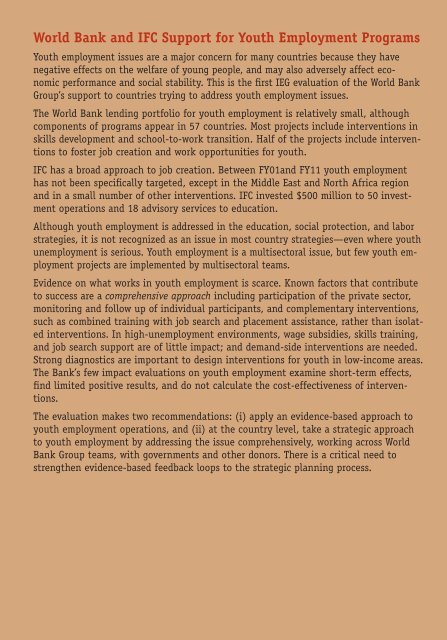Youth Employment Programs - Independent Evaluation Group
Youth Employment Programs - Independent Evaluation Group
Youth Employment Programs - Independent Evaluation Group
Create successful ePaper yourself
Turn your PDF publications into a flip-book with our unique Google optimized e-Paper software.
World Bank and IFC Support for <strong>Youth</strong> <strong>Employment</strong> <strong>Programs</strong><strong>Youth</strong> employment issues are a major concern for many countries because they havenegative effects on the welfare of young people, and may also adversely affect economicperformance and social stability. This is the first IEG evaluation of the World Bank<strong>Group</strong>’s support to countries trying to address youth employment issues.The World Bank lending portfolio for youth employment is relatively small, althoughcomponents of programs appear in 57 countries. Most projects include interventions inskills development and school-to-work transition. Half of the projects include interventionsto foster job creation and work opportunities for youth.IFC has a broad approach to job creation. Between FY01and FY11 youth employmenthas not been specifically targeted, except in the Middle East and North Africa regionand in a small number of other interventions. IFC invested $500 million to 50 investmentoperations and 18 advisory services to education.Although youth employment is addressed in the education, social protection, and laborstrategies, it is not recognized as an issue in most country strategies—even where youthunemployment is serious. <strong>Youth</strong> employment is a multisectoral issue, but few youth employmentprojects are implemented by multisectoral teams.Evidence on what works in youth employment is scarce. Known factors that contributeto success are a comprehensive approach including participation of the private sector,monitoring and follow up of individual participants, and complementary interventions,such as combined training with job search and placement assistance, rather than isolatedinterventions. In high-unemployment environments, wage subsidies, skills training,and job search support are of little impact; and demand-side interventions are needed.Strong diagnostics are important to design interventions for youth in low-income areas.The Bank’s few impact evaluations on youth employment examine short-term effects,find limited positive results, and do not calculate the cost-effectiveness of interventions.The evaluation makes two recommendations: (i) apply an evidence-based approach toyouth employment operations, and (ii) at the country level, take a strategic approachto youth employment by addressing the issue comprehensively, working across WorldBank <strong>Group</strong> teams, with governments and other donors. There is a critical need tostrengthen evidence-based feedback loops to the strategic planning process.
















